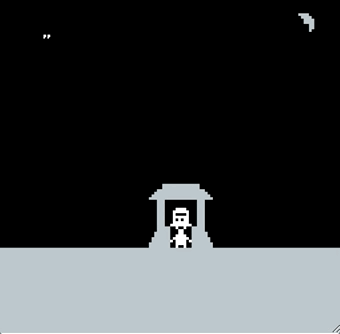detached.
- first 2 skylines: you are walking home when the stars begin disappearing out of the sky. how weird.
- 3rd skyline: a shrine appears that you’ve never seen here before. you can read it a little bit even though your japanese skills are rusty.
- 4th: a lone frog sits in the middle of your path. you approach it.
- 5th: oh! you’ve time-traveled! where even are you?
- 1st room: you’ve arrived to the nearest town. you can speak to a man, lady, and child to gain more clues about your whereabouts. they also give you some tasks to complete before you can participate in shogatsu – japanese new year.
- 2nd room: here is where the seamster lives! if you find his needle, he can mend a kimono and give it to you so you blend in more. when you search his quarters, keep in mind what you see.
- 3rd room: if you’ve helped the child find his lost toy, he will give you incense to use at this shrine. inside you will find the shrines themselves, a purification fountain, and a nearby old woman who tells you of the shrine’s caretaker who lives in the next room.
- 4th room: this is the shrine keeper’s personal quarters, who happens to be a young girl who is the same age as you. she gives you matches so you can light your incense. you can also look around her quarters for more clues.
- 5th room: once you have a kimono and have prayed to your ancestors, you can move along to the firework celebration ahead. approach the balcony so you can get a better look at the show!
- 6th room: you are back in your own time, you think. the firework you approached tells you how important your past is. when you turn to leave, you can pick up the same frog who helped you time travel from before.
In my Bitsy project, titled DETACHED, you follow a girl who feels indifferent about her Japanese heritage and disconnected from her traditional family. When walking home, she encounters a shrine with a proverb about a frog – then happens across an actual frog, and is taken back to a feudal era of Japan when she touches it. Utilizing McCloud’s love of the mystery between closure, I tried to implement many instances of something interesting happening between rooms in Bitsy. I used a wave transition to signify time traveling to the past, and a tunnel transition to showcase traveling a longer distance and showing up somewhere else entirely; because this is implied, the player is given time to wonder about the intrigue and mystery that the blanks of transitions offer (pg. 88). I found it a little difficult in the beginning to represent ancient Japan without being able to use all 5 senses, but in incorporating narrative snippets that give more detail to the world around the player character and taking care in creating solid visuals, I feel that I was able to convey all of the information that is important to the player’s experience (pg. 89). McCloud also details how difficult it is to achieve closure when images are closer to the picture plane, and in telling a story through Bitsy’s 8-bit means, I definitely began to understand this challenge. By keeping all of my visuals unified, I was still able to tell an adequate story about time travel (pg. 91). I also tried to be design conscious and place interactive sprites in a pattern from left-to-right, to mimic the way that we read and that player attention naturally spans – this is also touched upon by McCloud, who states that this sort of sequential layout can aid in setting up several separate spaces and time slots within one room or ‘panel’ (pg. 97).
I also took a few lessons out of the theme park videos we have gone over in class. One topic that initially intrigued me and eventually inspired me was the walkthrough video detailing the park known as Evermore, which gives guests a real-life chance at a Dungeons & Dragons campaign. What I really liked about this video is that it showed Kelsey completing a three-part quest that was unique to her experience, highlighting each moment of interaction and adventure as she went. This not only gave me a good idea of how to shape my own quests in a video game setting like Bitsy, but allowed me to see how both real life and video games can incorporate conditional elements. For Kelsey’s first task, she couldn’t move on until she managed to shoot three bullseyes at the archery range – in DETACHED, you cannot move on to the final scene of the game without having prayed to your ancestors in the shrine or receiving a kimono from the seamster. This is a mechanic that isn’t meant to bog you down with a to-do list before you can get to do cool things, but a vehicle to help players move through the created world and have a greater chance at experiencing richer moments. If there were no conditionals and no side tasks, much of the games we create would go untouched despite having important or easter egg-like details worked in. Without these details that we have placed there for a reason, I think a lot of the tedious beauty of video game development would go unappreciated.

Leave a comment
Log in with itch.io to leave a comment.